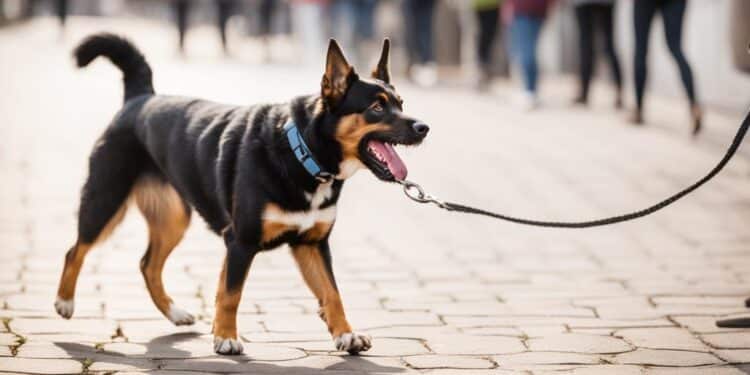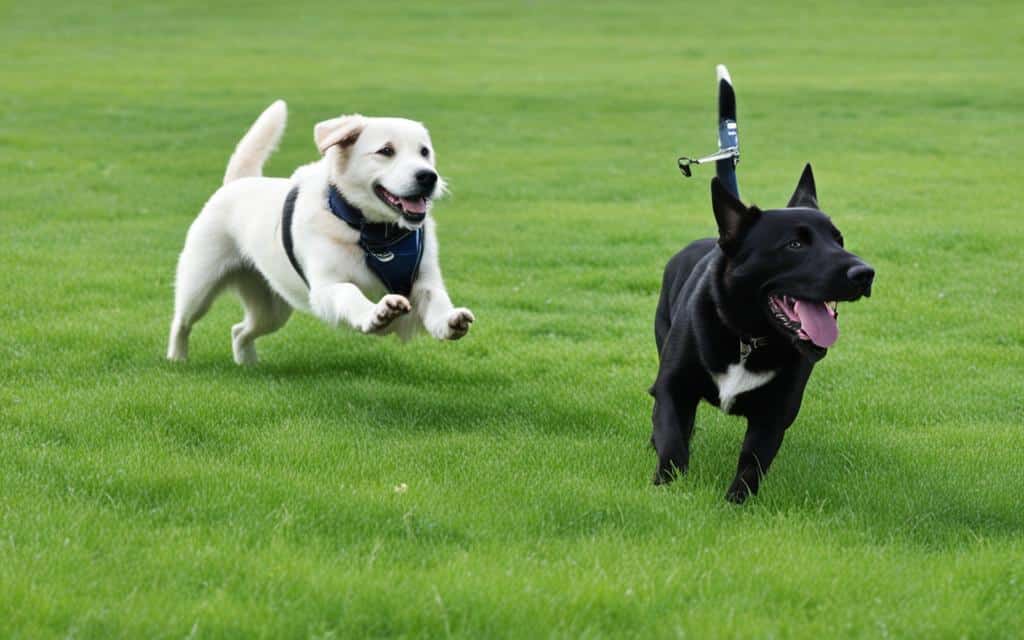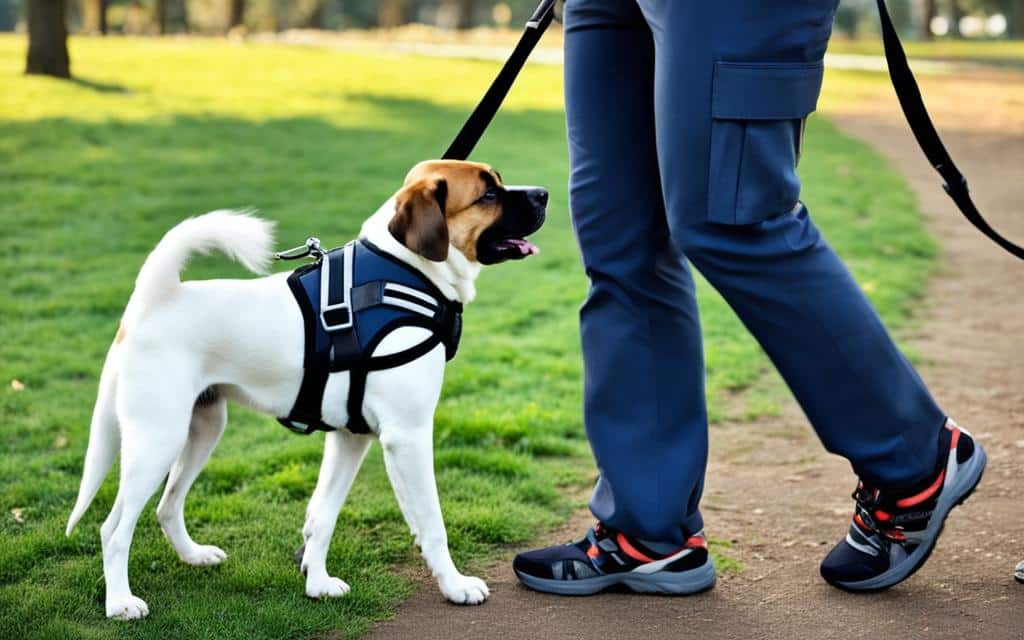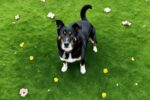Managing Leash Aggression in Dogs During Walks

Leash aggression is a common problem among dogs that can make walks stressful and challenging for both the dog and the owner. Leash-aggressive dogs behave calmly and politely when off-leash but become reactive when on a leash.
This behavior can be caused by a combination of frustration and tension, often stemming from a lack of proper socialization and canine communication skills. It is crucial for owners to understand the underlying causes of leash aggression and seek professional guidance to address this issue effectively.
In this article, we will discuss the various factors contributing to leash aggression, the importance of seeking professional assistance, and effective strategies for managing leash aggression through positive reinforcement and socialization techniques.
By implementing these techniques and consistently working with your dog, you can improve their walking behavior and create a more enjoyable and harmonious walking experience for both you and your furry friend.
Understanding Leash Aggression and its Causes
Leash aggression is a common issue that many dog owners face during walks. It is driven by a strong desire for social interaction with other dogs, but often stems from a lack of social skills in dogs. When on a leash, dogs with leash aggression may struggle to initiate positive interactions with other dogs and may exhibit behaviors such as lunging, barking, or snapping.
This type of behavior is typically prompted by frustration. Dogs with leash aggression may become increasingly reactive if the owner pulls them away from potential social interactions. Instead of using subtle communication signals, these dogs display more overt and aggressive behaviors as a means of communication.
Understanding a dog’s body language is crucial in managing leash aggression effectively. Recognizing signs of stress or discomfort can help owners anticipate and redirect their dog’s reactions before they escalate. Seeking professional help from a certified dog trainer or behaviorist is highly recommended to gain a deeper understanding of leash aggression and its underlying causes.
| Causes | Symptoms |
|---|---|
| Frustration from lack of socialization and social skills | Lunging, barking, or snapping at passing dogs |
| Past negative experiences with other dogs | Tail held high, stiff body posture |
| Anxiety or fear due to a traumatic event | Ears pinned back, excessive panting |
Proper understanding of leash aggression requires knowledge of dog behavior and the willingness to address the underlying issues. It is important to approach leash aggression with patience and support, providing the necessary guidance and training to help your dog overcome this challenge.
Seeking Professional Guidance for Leash Aggression
Addressing leash aggression requires the expertise of a professional dog trainer. When dealing with leash aggression, owners often need guidance in understanding and interpreting dog behavior. A professional trainer can assess the dog’s behavior and determine if it is a typical case of leash aggression.
If you’re facing issues with leash aggression in your dog, it’s crucial to seek the help of a qualified professional who can offer the necessary guidance. This expert can evaluate your dog’s behavior, identify specific triggers, and develop a customized training plan to address the issue effectively.
Before implementing any training methods, it’s essential to rule out any underlying medical causes that might be contributing to the leash aggression. A comprehensive veterinary exam will help identify any health issues that need to be addressed before proceeding with training.
By seeking professional guidance, you can ensure the safety and well-being of your dog and others. A professional dog trainer will have the knowledge and experience to manage leash aggression effectively, providing you with practical strategies and techniques to transform your dog’s walking experience.
Using Positive Reinforcement to Manage Leash Aggression
Positive reinforcement techniques can be highly effective in managing leash aggression in dogs. One popular training approach that can help address leash aggression is the “Cookie Dog” game. In this game, owners reward their dogs with high-value treats whenever they encounter another dog during a walk.
The presence of another dog is typically a trigger for dogs with leash aggression, leading to reactive behavior. By associating the presence of other dogs with positive experiences and rewards, the dog begins to develop a new, more positive association with these encounters. This game helps decrease the dog’s frustration and redirects their attention towards the owner during encounters with other dogs.
The “Cookie Dog” game can be implemented in the following steps:
- Begin by finding a comfortable distance from another dog where your dog is still calm and able to focus on you.
- As soon as your dog sees the other dog, use a verbal cue such as “Look” or “Focus” to redirect their attention towards you.
- Immediately reward your dog with a high-value treat and praise for looking at you.
- Continue to repeat this process, gradually decreasing the distance between your dog and the other dog as your dog becomes more comfortable.
Benefits of Positive Reinforcement
Using positive reinforcement techniques, such as the “Cookie Dog” game, has several advantages when managing leash aggression:
- Creates Positive Associations: By rewarding your dog for calm behavior around other dogs, you help create positive associations where they start to anticipate rewards rather than reacting with aggression.
- Redirects Attention: Positive reinforcement techniques redirect your dog’s focus towards you, promoting better control and reducing the likelihood of aggressive behavior.
- Strengthens Owner-Dog Bond: Consistently rewarding your dog for calm behavior during encounters with other dogs strengthens the bond between you and your furry friend.
Positive reinforcement techniques, such as the “Cookie Dog” game, provide a gentle and effective way to manage leash aggression in dogs, creating a more enjoyable walking experience for both the dog and the owner.
Establishing Control and Focus on Walks
In addition to positive reinforcement techniques, it is essential to establish control and focus during walks to prevent leash aggression. By implementing specific training cues and exercises, you can redirect your dog’s attention, reinforce calm behavior, and create a more enjoyable walking experience. Consistency, patience, and guidance from a professional trainer are key to achieving success in controlling leash aggression.
Training Cues for Focus
Training cues such as “Watch me” or “Focus” can be invaluable in redirecting your dog’s attention when encountering triggers during walks. These cues help to shift your dog’s focus back to you, promoting better communication and responsiveness. When practiced consistently, your dog will become more attentive to your commands and less reactive to external stimuli.
Teaching Sit and Stay
Training your dog to sit and stay in the presence of other dogs or distractions is another effective method to reinforce calm behavior and prevent leash aggression. By teaching your dog these basic commands, you can create a sense of control and ensure that your dog remains calm and composed during walks. Practice these commands in distracting environments gradually to strengthen your dog’s ability to remain focused and stay in position.
Consistency is Key
Consistency is crucial in establishing control and focus during walks. By consistently using training cues, reinforcing desirable behaviors, and practicing obedience exercises, you can effectively manage leash aggression. Remember to reward your dog for good behavior and remain patient throughout the training process.
Professional Guidance
Seeking guidance from a professional trainer is highly recommended when working on controlling leash aggression. A professional trainer can provide personalized advice, techniques, and ongoing support to help you effectively manage your dog’s walking behaviors. They will assess your dog’s specific needs and design a training plan tailored to address your dog’s leash aggression issues.
Table: Techniques to Establish Control and Focus on Walks
| Techniques | Description |
|---|---|
| Training cues | Teach your dog specific cues like “Watch me” or “Focus” to redirect their attention during walks. |
| Sit and Stay | Train your dog to sit and stay in the presence of other dogs or distractions to reinforce calm behavior. |
| Consistency | Consistently use training cues, reinforce positive behavior, and practice obedience exercises. |
| Professional guidance | Seek advice from a professional trainer who can provide personalized training plans and ongoing support. |
The Role of Socialization in Managing Leash Aggression
Proper socialization plays a crucial role in managing leash aggression. It is important for dogs to have positive experiences and interactions with other dogs from an early age. Through controlled and supervised off-leash interactions with well-behaved dogs, leash-aggressive dogs can develop the necessary social skills and reduce their reactivity.
Socialization should be approached as a gradual process, ensuring the safety and well-being of both the dog and others involved. It is essential for owners to seek guidance from a professional trainer, who can provide valuable insights on how to properly socialize a leash-aggressive dog.
Socialization allows dogs to learn appropriate behaviors, understand canine communication, and build confidence in various social settings. By exposing leash-aggressive dogs to positive dog interactions, they can learn to associate other dogs with pleasant experiences, reducing their tendency to react aggressively on a leash.
Exposing dogs to well-behaved and friendly dogs in controlled settings is crucial. This can be achieved through obedience classes, supervised playdates, or interactions with other dogs from trusted friends or family members. Gradually increasing the duration and intensity of these interactions, while monitoring the dog’s behavior and response, enables the dog to learn and adapt to new social situations.
It is important to note that socialization should always prioritize safety. Avoiding situations that may trigger aggressive behavior, such as crowded dog parks or overwhelming environments, can help create a positive socialization experience for the dog.
| Activities | Description |
|---|---|
| Obedience Classes | Enroll the dog in obedience classes that focus on positive reinforcement and controlled dog-dog interactions. |
| Supervised Playdates | Arrange playdates with other well-behaved and friendly dogs in a controlled environment with experienced dog owners. |
| Structured Walks | Walk the dog in areas with a low dog population, gradually introducing controlled interactions with other calm and well-behaved dogs. |
| Canine Sports | Participate in activities like agility or nose work, which provide structured social experiences in a controlled setting. |
| Professional Training | Seek guidance from a professional dog trainer who specializes in leash aggression and socialization to design a customized training plan. |
When socializing a leash-aggressive dog, patience and consistency are key. Each dog is unique, and progress may vary. Celebrating small victories and providing positive reinforcement for desired behaviors can significantly contribute to the success of socialization efforts.
With proper socialization and guidance from professionals, owners can help their leash-aggressive dogs develop the necessary social skills, leading to more positive and enjoyable dog interactions during walks and beyond.

Setting Realistic Expectations and Taking Precautions
When it comes to managing leash aggression in dogs, it’s important for owners to set realistic expectations. While complete elimination of leash aggression may not be possible in all cases, the goal should be to reduce the intensity and frequency of aggressive behaviors. By understanding the underlying causes and seeking professional guidance, owners can take steps to effectively manage leash aggression and create a more peaceful walking experience.
Alongside setting realistic expectations, it is crucial for owners to prioritize safety when dealing with leash-aggressive dogs. Taking precautionary measures can help create a stress-free walking environment. One effective safety measure is to avoid crowded areas or alter walking routes to minimize triggers that may provoke aggressive behavior. This can help reduce the chances of confrontations with other dogs and prevent any potential incidents.
Another important safety measure is to ensure the use of appropriate equipment, such as a sturdy leash and harness, to maintain control over the dog during walks. This not only ensures the safety of the dog but also instills confidence in the owner, reducing the likelihood of tension or anxiety that may contribute to leash aggression.
Consulting with a professional trainer is essential for personalized advice on managing leash aggression and implementing safety measures effectively. They can assess the specific needs of the dog and provide guidance on training techniques, handling skills, and behavior modification strategies to address leash aggression.
By setting realistic expectations and taking adequate safety measures, owners can work towards managing leash aggression in their dogs, providing a safer and more enjoyable walking experience for both the dog and the owner.

Conclusion
Managing leash aggression in dogs during walks can be a daunting task, but with the right guidance and training techniques, it is possible to improve a dog’s walking behavior and reduce leash aggression. Seeking professional help from a qualified dog trainer is crucial in understanding and addressing the underlying causes of leash aggression. Through a thorough veterinary exam, any potential medical issues can be ruled out, ensuring that the chosen training methods are appropriate for the dog’s specific needs.
Positive reinforcement techniques are effective in managing leash aggression. By using rewards such as high-value treats, owners can redirect their dog’s attention and create positive associations with encounters on walks. Establishing control and focus through training cues like “Watch me” or “Focus” helps the dog stay calm and attentive, reducing the chances of leash aggression.
Socialization also plays a vital role in managing leash aggression. Gradual and controlled off-leash interactions with well-behaved dogs can help build a dog’s social skills and reduce leash aggression. Patience, consistency, and a commitment to training are key in achieving success. While complete elimination of leash aggression may not be possible in all cases, the goal should be to reduce the intensity and frequency of aggressive behaviors, creating a stress-free walking experience for both the dog and the owner.
FAQ
What is leash aggression?
Leash aggression refers to dogs behaving calmly and politely when off-leash but becoming reactive, such as lunging, barking, or snapping, when on a leash.
What causes leash aggression in dogs?
Leash aggression is often caused by a combination of frustration and tension, stemming from a lack of proper socialization and canine communication skills.
How can a professional trainer help with leash aggression?
A professional dog trainer can assess the dog’s behavior, determine if it is leash aggression, and provide guidance and training methods to address this issue effectively.
What are some positive reinforcement techniques for managing leash aggression?
One effective technique is the “Cookie Dog” game, where owners reward their dog with high-value treats when they see another dog on a walk, helping to associate the presence of other dogs with positive experiences.
How can I establish control and focus during walks to prevent leash aggression?
Training cues like “Watch me” or “Focus” can help redirect the dog’s attention to the owner when encountering triggers, and teaching the dog to sit and stay in the presence of other dogs can reinforce calm behavior.
What is the role of socialization in managing leash aggression?
Proper socialization, which includes controlled off-leash interactions with well-behaved dogs, can help develop the dog’s social skills and reduce leash aggression.
Can leash aggression be completely eliminated?
While complete elimination may not be possible in all cases, the goal should be to reduce the intensity and frequency of aggressive behaviors through proper training and precautions.
How can I create a stress-free walking experience for my dog?
By taking precautions, such as avoiding crowded areas or altering walking routes to minimize triggers, and consulting with a professional trainer, you can help ensure a stress-free walking experience for both you and your dog.






